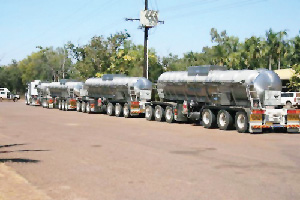
Drydock operator mitigates layoffs
The operator of the three floating docks in Walvis Bay, EBH Namibia said only 20 employees will be affected by compulsory retrenchment following nine weeks of negotiation between the company and the Mining Metals Maritime and Construction union.
Elgin Brown & Hamer (EBH) Namibia was forced to retrench 102 employees following a collapse of revenues as a result of the slump in ship maintenance which came in the wake of the receding oil price. EBH Namibia is a joint venture between EBH South Africa and the Namibian Ports Authority, Namport.
“At the time of the decision to retrench employees, EBH Namibia employed 551 people comprising 466 permanent staff and 85 fixed-term contractors. Of the 102 employees retrenched, 82 opted for voluntary separation; while ultimately only 20 employees had to take compulsory retrenchment” the company stated in an update on their retrenchments.
“Of the 82 employees voluntarily retrenched, there were 17 in the 55 – 62 year age bracket, of whom seven volunteered for early retirement,” explained Hannes Uys, CEO of EBH Namibia.
“It is also noteworthy that 71.3% of those leaving EBH Namibia opted for early retirement or voluntary retrenchment; and that compulsory retrenchments made up less than 30 % of the total number of employees retrenched,” he said. All the retrenched staff stopped working on 29 July.
“It is a painful decision to have to retrench and not something we took lightly,” said Uys, emphasising that it is EBH Namibia’s hope that the retrenchment packages will assist the affected employees to move forward constructively.
With a prolonged low oil price and depressed economic cycle, it was imperative for the company to reduce costs and improve efficiencies. In March 2015, EBH Namibia began proactively implementing stringent performance improvement projects.
In spite of these proactive steps, EBH Namibia continued to experience a 50% decline in docking activity. In response, the company carefully analysed both operational and human resources aspects of the company. It was found that, in spite of the savings brought about by the performance improvements, the prolonged downturn dictated a company-wide restructuring and stabilisation programme, announced in April this year.
In deciding to implement the retrenchment decision, EBH Namibia worked closely with the MMMC, the EBH Namibia Workers Representative Committee (WRC) and the Ministry of Labour. To reduce compulsory retrenchments to a minimum, early retirement and voluntary retrenchment options were offered to all EBH Namibia employees, irrespective of their seniority.
Regarding EBH Namibia’s relationship with the union and the workers committee, Uys said: “Our relationship with the MMMC and the WRC as strategic partners is good, and we are continuing to enhance it. We would also like to extend our sincere thanks to both parties for their cooperation leading up to signing of the Retrenchment Agreement,” he said.
“There is the very real possibility that, when the oil price strengthens, we will be able to re-employ some of those whom we have just had to retrench,” he stated.












































